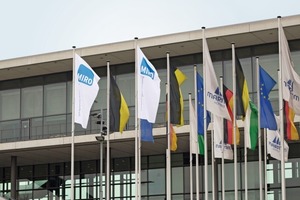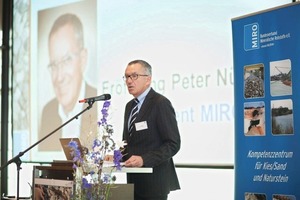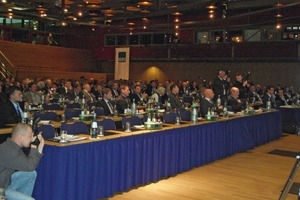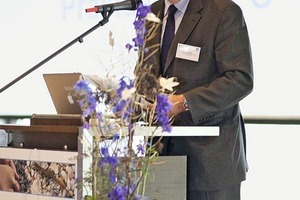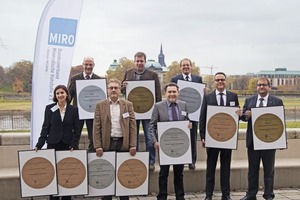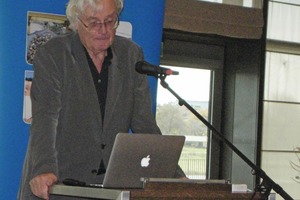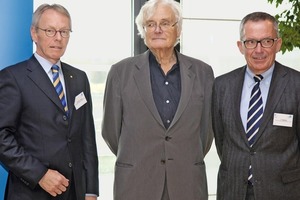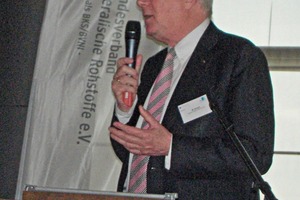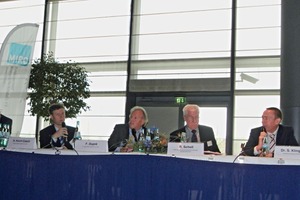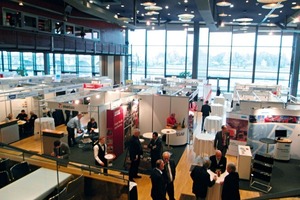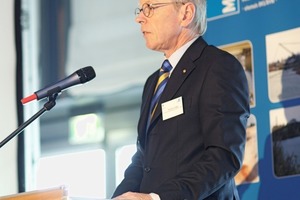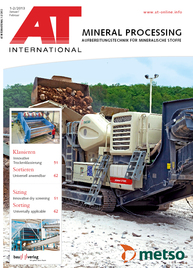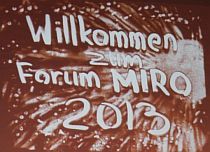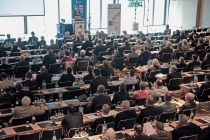ForumMIRO – Meeting place of the German rock industry, part 1
Peter Nüdling (Fig. 1), President of the Federal Mineral Raw Material Association (MIRO), welcomed more than 400 participants to the International Congress Centre in Dresden on the occasion of the 5th ForumMIRO, which took place from 7. to 9. November 2012 (Fig. 2). After the overwhelming success last year, it could be expected that the practically oriented event would also be of great interest this year. The number of visitors and exhibitors proved this. In fact, even more exhibitors were represented at the trade exhibition this year and the exhibition area was extended.
Based on the demand and production figures for 2012/13, Peter Nüdling predicted good prospects for the branch when talking about the economic situation of the association. Approximately 253 million tons of gravel and sand (+10.5 %) and 229 million tons of natural stone (+10.1 %) were produced consumer-consciously and according to the requirements in 2011. In his opinion, the reasons for this are the favourable conditions for the creation of residential property (real estate for owner occupation and as invested capital). An increase in capital spending of about 3 % should be expected in residential construction. While reduced capital spending in public building construction and a slight increase in public civil engineering should be expected. The energy turnaround also gave impetus to the building industry. According to data from ‘trend research’, capital spending of about 250 million € is required for the period 2011-2012. However, the share of the construction industry is not clear.
The importance of secondary raw materials as potential raw material source is overestimated by politics. The current monitoring report of the Working Group for Building Industry Sponsors of Closed Cycle and Waste Management Policy proves that the cycling of materials is almost completely closed in the mineral segment. The recycling building materials used amount to about 12 % of the overall need for rock products. Realistically seen, it will not be possible to increase this rate due to the insufficiency of materials. As regards the implementation of projects, Nüdling criticized the slow-moving reconstruction of roads and bridges due to the still insufficient financial resources for the upgrading of the traffic infrastructure. Therefore, MIRO and other associations demand capital spending for this purpose amounting to 14 million € in 2013. However, the Federal Minister of Transport, Ramsauer, only has 10 million € at his disposal. Will this compellingly lead to a car toll? In spite of all imponderabilities, the branch is expecting an exciting 2013.
In his words of welcome, the President of the European Aggregates Association (UEPG), Arnaud Colson/France (Fig. 3), underlined the importance of the UEPG in the EU and, in particular, the special role of Germany as the largest rock producer and most economic member state with high resource efficiency, biodiversity and recycling ratio. One of the most important tasks of the UEPG is the preparation of a European rock strategy by 2030.
Industrial safety is a top priority in the field of gravel and sand extraction! As every year, at this conference, the best companies were honoured as regards the MIRO competition of industrial safety (Fig. 4). For example, the Kupferberg works of Hartsteinwerke Schicker OHG in the field of natural stone and the Wallendorf works of Mitteldeutsche Baustoffe GmbH in the field of sand and gravel were presented with a gold certificate. The industrial safety competition, combined with the annual accident statistics, is considered a motivation factor for the companies.
Prof. Dr. h.c. mult. Meinhard von Gerkan (Fig. 5) started his lecture with the above statement. Actually he dissociated himself from the title of his lecture “The personal pride of the architect determines the character of the building”. However, he showed in his lecture that it corresponds with the reality. His motto regarding today’s architecture is that it has to comply with the following four principles: simplicity, structural order, individuality and the balance between versatility and simplicity. Prof. Gerkan started his lecture looking back at the times of the construction of the pyramids and made a historical excursion through the architecture up to the present day with many illustrations. Particularly attractive designs from his firm for projects in China, Taiwan and Vietnam, and also in Germany (Tegel Airport and in Berlin-Brandenburg as well as the new Berlin central station) illustrate the four premises forming the basis of the work of the author. These buildings show how building materials, a wealth of ideas and aesthetic combine to become a perfectly shaped, architectural unit.
In his words of thanks, the General Manager of MIRO, Prof. Dr. Ulrich Hahn, underlined that the focus on the essentials is not only a maxim of the activities of Prof. Gerkan. The work of the association is characterized by similar priorities (Fig. 6).
A detailed report on the workshops held later in the course of the event will be published in the next issue of AT INTERNATIONAL.
Author: Dr. Brigitte Hoffmann, Fachbüro für Abfallberatung und Umweltschutz, Oberschöna/Germany

